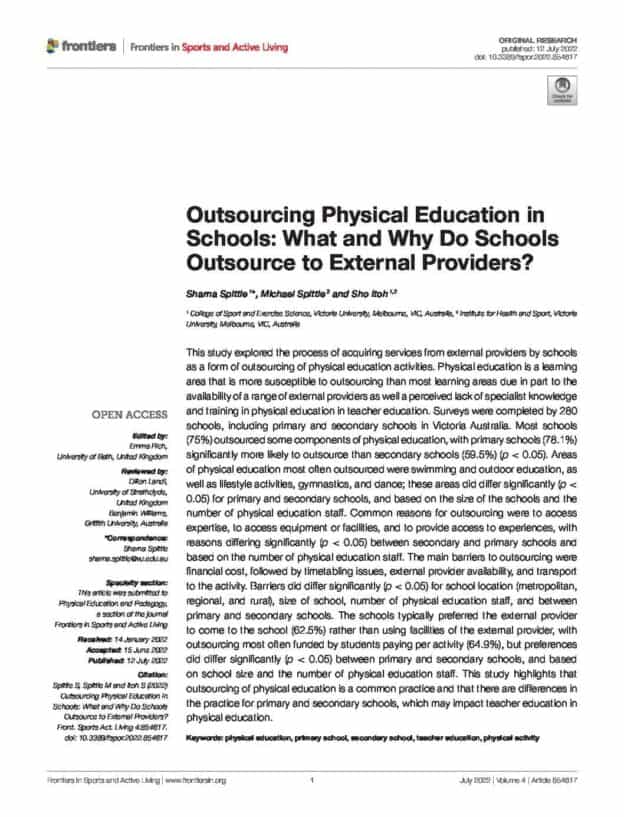This study explored the process of acquiring services from external providers by schools as a form of outsourcing of physical education activities. Physical education is a learning area that is more susceptible to outsourcing than most learning areas due in part to the availability of a range of external providers as well a perceived lack of specialist knowledge and training in physical education in teacher education. Surveys were completed by 280 schools, including primary and secondary schools in Victoria Australia. Most schools (75%) outsourced some components of physical education, with primary schools (78.1%) significantly more likely to outsource than secondary schools (59.5%) (p < 0.05). Areas of physical education most often outsourced were swimming and outdoor education, as well as lifestyle activities, gymnastics, and dance; these areas did differ significantly (p < 0.05) for primary and secondary schools, and based on the size of the schools and the number of physical education staff. Common reasons for outsourcing were to access expertise, to access equipment or facilities, and to provide access to experiences, with reasons differing significantly (p < 0.05) between secondary and primary schools and based on the number of physical education staff. The main barriers to outsourcing were financial cost, followed by timetabling issues, external provider availability, and transport to the activity. Barriers did differ significantly (p < 0.05) for school location (metropolitan, regional, and rural), size of school, number of physical education staff, and between primary and secondary schools. The schools typically preferred the external provider to come to the school (62.5%) rather than using facilities of the external provider, with outsourcing most often funded by students paying per activity (64.9%), but preferences did differ significantly (p < 0.05) between primary and secondary schools, and based on school size and the number of physical education staff. This study highlights that outsourcing of physical education is a common practice and that there are differences in the practice for primary and secondary schools, which may impact teacher education in physical education.

Related Research
-
This guidance is for school leaders and teachers considering the rationale for character education and personal development, and the practicalities of provision and delivery. The guidance will support schools as they consider: the 2019 Ofsted inspection framework the social, moral, cultural and spiritual development of pupils preparations for the introduction of ‘Relationships education’ and ‘Health education’ in primary schools, and…
-
PE is a compulsory subject under the National Curriculum at all key stages; National Curriculum programmes of study outline what should be taught at each key stage. Local authority maintained schools are required to follow the National Curriculum; academies and free schools do not have to follow it but are required to provide a broad and balanced curriculum that promotes the physical…
-
The education inspection framework has been devised by Her Majesty’s Chief Inspector for use from September 2019. It sets out the principles that apply to inspection, and the main judgements that inspectors make when carrying out inspections of maintained schools, academies, non-association independent schools, further education and skills providers and registered early years settings in England. The education inspection framework…


Responses